
The Virtual Shtetl (Polish : Wirtualny Sztetl) is a bilingual Polish-English portal of the Museum of the History of Polish Jews in Warsaw, devoted to the Jewish history of Poland.

The Virtual Shtetl (Polish : Wirtualny Sztetl) is a bilingual Polish-English portal of the Museum of the History of Polish Jews in Warsaw, devoted to the Jewish history of Poland.
The Virtual Shtetl website was officially launched on June 16, 2009 by founder Albert Stankowski. The portal lists over 1,900 towns with maps, statistics and picture galleries. In the future, it will also include an interactive system by which Internet users will interact with each other. It creates a link between Polish-Jewish history and the contemporary, multi-cultural world.
The Virtual Shtetl is an extension of the real Museum scheduled to open in 2011 on the site of the Warsaw ghetto. Its main objective is to provide a unique social forum for everyone interested in Polish-Jewish life. The "Virtual Shtetl" re-tells the history of Polish Jews which existed, to a great extent, in a town or a village (Yiddish: shtetl). But besides that, it also provides information about German Jews and the Jewish life of the Eastern territories of Germany.
The portal provides information on small towns and big cities—both about the past and the present. It covers both contemporary and pre-war Poland. The English version enables Jews from all over the world to research their own Polish ancestry. Creating a fuller picture of Polish-Jewish history and Polish-Jewish relations was possible thanks to the efforts of many institutions, organizations and individuals. Because the subject is so broad, the initiatives for further research and development are considered infinite. Numerous resources have been provided by the Polin portal and the Jewish.org.pl community portal. Other Internet projects which have participated were the www.izrael.badacz.org and Diapozytyw (Adam Mickiewicz Institute) as well as the Jewish Historical Institute. [1]

Płock is a city in central Poland, on the Vistula river, in the Masovian Voivodeship. According to the data provided by GUS on 31 December 2021, there were 116,962 inhabitants in the city. Its full ceremonial name, according to the preamble to the City Statute, is Stołeczne Książęce Miasto Płock. It is used in ceremonial documents as well as for preserving an old tradition.

Otwock is a city in east-central Poland, some 23 kilometres (14 mi) southeast of Warsaw, with 44,635 inhabitants (2019). Otwock is a part of the Warsaw Agglomeration. It is situated on the right bank of Vistula River below the mouth of Swider River. Otwock is home to a unique architectural style called Swidermajer.

Sokółka is a town in northeastern Poland, seat of the Sokółka County in Podlaskie Voivodeship. It is a busy rail junction located on the international Warsaw–Białystok–Grodno line, with additional connections which go to Suwałki and the Lithuanian border.
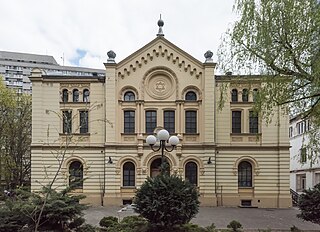
The Nożyk Synagogue is the only surviving prewar Jewish house of prayer in Warsaw, Poland. It was built in 1898-1902 and was restored after World War II. It is still operational and currently houses the Warsaw Jewish Commune, as well as other Jewish organizations.
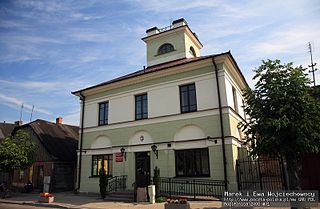
Mogielnica is a town in Grójec County in Masovian Voivodeship, Poland, with 2,475 inhabitants (2004) and an area of 141.56 square kilometres. It is the seat of Gmina Mogielnica. In other languages, it is referred to as Mogelnitsa, Mogelnitse, Mogelnitza and/or Mogielnicy.
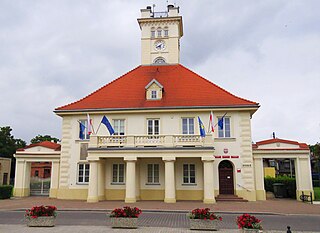
Błonie is a town in Warsaw West County, Masovian Voivodeship, Poland, with a population of 12,058 as of December 2021.

Przedbórz is a town in Radomsko County, Łódź Voivodeship, Poland, with 3,458 inhabitants (2020). Przedbórz is situated on the Pilica River in the northwestern corner of the historic province of Lesser Poland. From its foundation until the Partitions of Poland, it belonged to Lesser Poland’s Sandomierz Voivodeship.

Radzanów is a village in Mława County, Masovian Voivodeship, in east-central Poland, approximately 28 kilometres (17 mi) south-west of Mława and 101 km (63 mi) north-west of Warsaw. It is the seat of the gmina called Gmina Radzanów.

The Łańcut Synagogue is a Baroque synagogue in Łańcut, Poland. The Łańcut Synagogue is a rare surviving example of the vaulted synagogues with a bimah-tower, that were built throughout the Polish lands in masonry from the sixteenth through the early nineteenth centuries.

POLIN Museum of the History of Polish Jews is a museum on the site of the former Warsaw Ghetto. The Hebrew word Polin in the museum's English name means either "Poland" or "rest here" and relates to a legend about the arrival of the first Jews to Poland.

The Częstochowa Ghetto uprising was an insurrection in Poland's Częstochowa Ghetto against German occupational forces during World War II. It took place in late June 1943, resulting in some 2,000 Jews being killed.

Radom Ghetto was a Nazi ghetto set up in March 1941 in the city of Radom during the Nazi occupation of Poland, for the purpose of persecution and exploitation of Polish Jews. It was closed off from the outside officially in April 1941. A year and a half later, the liquidation of the ghetto began in August 1942, and ended in July 1944, with approximately 30,000–32,000 victims deported aboard Holocaust trains to their deaths at the Treblinka extermination camp.

The Mińsk Mazowiecki Ghetto or the Mińsk Ghetto was a World War II ghetto set up by Nazi Germany in occupied Poland. Some 7,000 Polish Jews were imprisoned there from all neighbouring settlements for the purpose of persecution and exploitation. Two years later, beginning 21 August 1942 during the most deadly phase of the Holocaust in occupied Poland, they were rounded up – men, women and children – and deported to Treblinka extermination camp aboard Holocaust trains. In the process of Ghetto liquidation, some 1,300 Jews were summarily executed by the SS in the streets of Mińsk Mazowiecki.
The history of the Jews in Łęczna, Poland is first recorded and dated to 1501. The Jewish community of the town was evident and stable until the holocaust, after which it ceased to exist. The Glincman family from Wlodawa sent some family members to live there in the late 1800s to widen their business to surrounding towns. Nowadays monuments and buildings are still visible and commemorated in town.

The Gwoździec Synagogue was a synagogue located in the former Polish–Lithuanian Commonwealth in what is now Hvizdets in Ukraine. Built in the mid-17th century, the synagogue endured severe damage during the First World War, and was destroyed by the Nazis in 1941. The synagogue is notable for its highly elaborate ceiling decorations, which were reconstructed at the POLIN Museum of the History of Polish Jews.
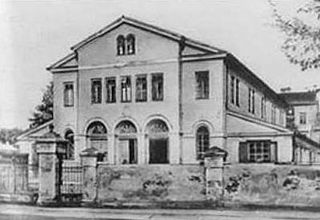
The Siedlce Ghetto, was a World War II Jewish ghetto set up by Nazi Germany in the city of Siedlce in occupied Poland, 92 kilometres (57 mi) east of Warsaw. The ghetto was closed from the outside in early October 1941. Some 12,000 Polish Jews were imprisoned there for the purpose of persecution and exploitation. Conditions were appalling; epidemics of typhus and scarlet fever raged. Beginning 22 August 1942 during the most deadly phase of the Holocaust in occupied Poland, around 10,000 Jews were rounded up – men, women and children – gathered at the Umschlagplatz, and deported to Treblinka extermination camp aboard Holocaust trains. Thousands of Jews were brought in from the ghettos in other cities and towns. In total, at least 17,000 Jews were annihilated in the process of ghetto liquidation. Hundreds of Jews were shot on the spot during the house-to-house searches, along with staff and patients of the Jewish hospital.

Zofia Glazernée Olszakowska and Cypora Zonszajnnée Jabłoń (1915–1942) were two close friends from the prewar Gymnasium of Queen Jadwiga in the city of Siedlce, in the Second Polish Republic. Cypora (Cypa) was a Polish Jew born into an affluent family. Zofia was the daughter of a local Catholic pharmacist in Siedlce. They studied together for their final matura exam, after which the two girls went their separate ways until the Holocaust in occupied Poland.
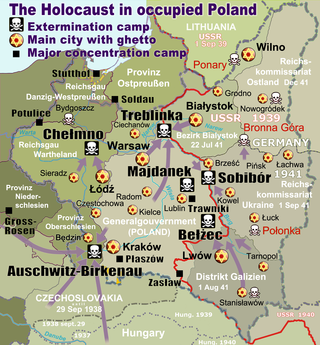
The Słonim Ghetto was a Nazi ghetto established in 1941 by the SS in Slonim, Western Belarus during World War II. Prior to 1939, the town (Słonim) was part of the Second Polish Republic. The town was captured in late June 1941 by the Wehrmacht in the early stages of Operation Barbarossa. Anti-Jewish measures were promptly put into place, and a barb-wire surrounded ghetto had been created by 12 July. The killings of Jews by mobile extermination squads began almost immediately. Mass killings took place in July and November. The survivors were used as slave labor. After each killing, significant looting by the Nazis occurred. A Judenrat was established to pay a large ransom; after paying out 2 million roubles of gold, its members were then executed. In March 1942, ghettos in the surrounding areas were merged into the Słonim ghetto.

The Kielce Ghetto was a Jewish World War II ghetto created in 1941 by the Schutzstaffel (SS) in the Polish city of Kielce in the south-western region of the Second Polish Republic, occupied by German forces from 4 September 1939. Before the Nazi invasion of Poland in 1939, Kielce was the capital of the Kielce Voivodeship. The Germans incorporated the city into Distrikt Radom of the semi-colonial General Government territory. The liquidation of the ghetto took place in August 1942, with over 21,000 victims deported to their deaths at the Treblinka extermination camp, and several thousands more shot, face-to-face.